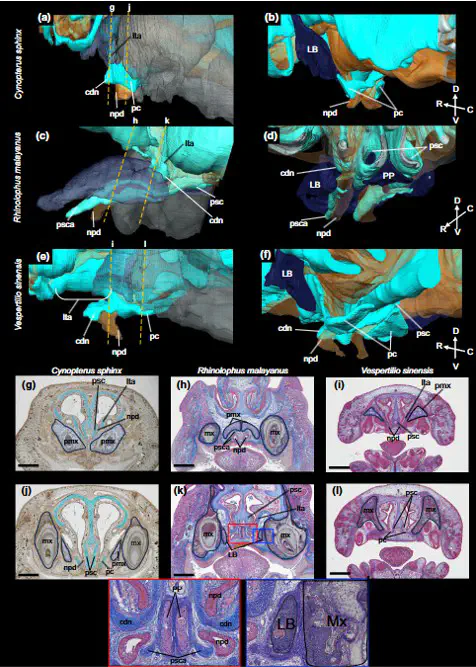The development of orofacial complex in bats: Implications for orofacial clefting

Abstract
Orofacial morphology in mammals plays a critical role in essential life functions suchas feeding and communication, which are influenced by the shapes of these anatomi-cal structures. Bats are known to exhibit highly diversified orofacial morphotypeswithin their clade, reflecting their varied diets and echolocation behaviors. The pres-ence of bony discontinuities between the premaxilla and maxilla or among the pre-maxillae is a notable feature of bat orofacial morphology, observed in certain lineages.It is suggested that these unique orofacial morphotypes, not generally found in othermammals, have evolved in relation to dietary adaptations rather than merely for echo-location mode. Until now, the developmental background of the bony discontinuitiesin the bat orofacial complex has been insufficiently investigated. Here, we present acomparative study of the chondrocranium and epithelial organs in the orofacial com -plex of three bat species: Cynopterus sphinx, Rhinolophus malayanus, and Vespertiliosinensis. Our observations indicate that the preceding morphogenesis of orofacial car-tilage and epithelial structures is remarkably different among these three species. InC. sphinx and V. sinensis, the region forming from the regression of the palatine pro-cess of the premaxilla was filled with orofacial cartilage and epithelial structures. Wealso found that the clefted morphology observed in R. malayanus and V. sinensis wasformed via contrastingly divergent developmental processes. Midline clefts amongYangochiroptera have been previously categorized to represent a uniform morpho-type, but our study highlights that attributing midline clefts into a singular categoryshould be revisited, advocating for a nuanced categorization of cleft morphologybased on their morphogenetic patterns. Further research on the bat orofacial complexmay enhance our understanding of bat evolutionary diversification and offer insightsinto the developmental mechanisms of human cleft palate.
Fumiya Meguro, Hiroki Higashiyama, Yannick Pommery, Laura A.B. Wilson, Vuong Tan Tu, Taro Nojiri, Dai Fukui, Daisuke Koyabu
Journal of Anatomy (2024)